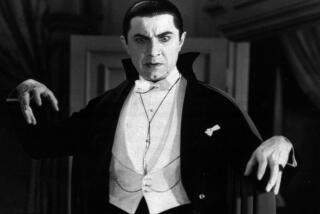Media images of Black death come at a cost, experts say. And many viewers are fed up
- Share via
Robeson Taj Frazier was uneasy when he started seeing ads for Amazon’s “Them,” about a Black family in the 1950s being terrorized by hostile white neighbors and supernatural forces.
The USC professor, who is the director of the Institute for Diversity and Empowerment (IDEA) at USC’s Annenberg School of Communication, feared that the drama would contain disturbing images of violence and brutality toward Black people, echoing scenes in HBO’s “Watchmen” and “Lovecraft Country” and other recent projects that mashed up the troubled history of racial turmoil in America with genre elements.
For the record:
10:52 a.m. April 19, 2021An earlier version of this article stated that Sophie Turner-White starred in “Queen & Slim.” Jodie Turner-Smith starred in the 2019 film.
His concerns were underscored when a social media uproar erupted soon after the show’s premiere earlier this month. Numerous Black viewers were outraged over its depictions of vicious racist violence, including the murder of a Black infant while his mother is being raped and a scene showing a Black couple being blinded with hot pokers and then burned to death.
In particular, these viewers — and professional critics — have denounced the series for exploiting Black trauma for profit: “It’s racial horror porn,” one wrote, “[and] I’m done supporting any of it.”
“Them,” about a Black family fighting racism and supernatural forces in the 1950s, includes warnings about its graphic depictions of racist violence.
Said Frazier: “I can certainly understand the negative reaction, and why viewers found the violence a bit excessive. Have we seen this kind of terrorization of other races on TV? People recognize there is a need and necessity to tell difficult stories, to interrogate the sickness of this infrastructure of white supremacy. But people are also asking, ‘at what cost?’”
The Oscar-nominated live-action short “Two Distant Strangers,” which premiered on Netflix the same day “Them” arrived on Amazon Prime Video, has raised similar questions with its story ofa young Black man trapped in a “Groundhog Day”-style cycle with a white cop who delights in killing him over and over again.
The growing furor around “Them,” “Two Distant Strangers” and other Hollywood projects containing horrific images of mayhem, maiming and murder directed at Black people has given new life to the debate over what many have characterized as “black trauma porn,” where the brutalization of Black bodies is presented as entertainment.
The artists behind these projects have countered charges that the scenarios are gratuitous by saying the pain of racism should not be sugarcoated.
Travon Free, the writer and co-director of “Two Distant Strangers,” said at a filmmaker panel this week: “There’s no way to avoid the fact that the reality of being Black is often painful and often traumatic.” “Them” creator and executive producer Little Marvin has said his admittedly upsetting images are designed to convey the savagery of racism.
Critics maintain that, while they respect the right of the writers, directors and producers to make strong artistic statements about race and racism, the ferocity of some of these images is more triggering than impactful. The images are particularly unsettling given the country’s real-life reckoning with police brutality against unarmed Black men, a divisive presidential election and the resurgence of white supremacist groups.
“Them” launched two days before the fatal shooting of 20-year-old Daunte Wright by a white police officer during a traffic stop in Brooklyn Center, Minn. That incident came in the midst of the nearby trial of Minneapolis police officer Derek Chauvin for the murder of George Floyd, during which witnesses have been overcome with emotion in recounting the trauma of watching the handcuffed Floyd die as Chauvin knelt on Floyd’s neck.
Scholars of pop culture say that showcasing Black pain and suffering in entertainment can be psychologically and emotionally harmful, particularly for Black audiences.
Mark Anthony Neal, chair of the African and African American studies department at Duke University, said: “For white audiences, these projects offer an opportunity to see things they may not see on a regular basis, while for Black folks, it’s the same old, same old. People are really sensitive and raw about the graphicness of the violence because, for them, it’s not entertainment.”
He added, “These directors and screenwriters are working in a world of fantasy. But the irony for Black folks is that it’s not a far cry from that fantastic world to the reality of how we live our lives. I can understand why they might want to push that away.”
Maryann Erigha, the author of “The Hollywood Jim Crow: The Racial Politics of the Movie Industry,” said, “People are right to say it’s alarming and that they find it traumatic. The depiction of Black death is permitted in mainstream media in a way that you don’t see at all with other racial groups. I don’t think it would be tolerated.”
Added Frazier: “We’re living and having to navigate the constant terrorization of Black bodies and the destruction of our flesh and then having to endure that while you think you’re watching escapist fare in your household.”
In defending their searing images, Little Marvin and Free insist their intent is not to be offensive or exploitative.
“Them” centers on the fictional Emory family, who relocate to California during the Great Migration when millions of Black families fled the oppressive Jim Crow South. The series uses horror movie elements grounded in the supernatural, a storytelling device Little Marvin said he wanted to use to reflect America’s racial unrest. But viewers, including Amazon executives, have been more “shaken” by the series’ realistic depictions of violence.
In one flashback, white marauders invade the family’s North Carolina home while Lucky Emory (Deborah Ayorinde) is alone with her infant son. As the men rape Lucky, a female accomplice stuffs the baby in a pillowcase and whirls it over her head while chanting “cat in a bag.” When she drops it to the ground, blood seeps through the pillowcase containing the lifeless baby.
Although Little Marvin, who said the idea for the scene came to him in a nightmare, is the main architect of “Them,” much of the backlash has been aimed at Emmy winner Lena Waithe, an executive producer on the series and the most well-known name associated with it. In their critiques of “Them,” several Black viewers made reference to 2019’s “Queen & Slim,” written by Waithe, as another example of exploiting Black pain and suffering. The film stars Daniel Kaluuya and Jodie Turner-Smith as heroic Black outlaws celebrated for fighting back against a racist cop only to be mowed down by police just as they are about to escape.
“Two Distant Strangers” touches on similar subject matter, albeit in a form that would comfortably fit into the “Twilight Zone” universe. The short film finds graphic artist Chester (rapper Joey Bada$$) trying to get home to his dog after spending the night with Perri (Zaria), a beautiful woman he just met. But every time he steps outside, he encounters Officer Merk (Andrew Howard), who harasses him. Their confrontations always end with Chester being killed and he wakes up back in bed with Perri, repeating the cycle.
While this time-loop formula is designed to condemn police brutality, the film, which references Eric Garner, Breonna Taylor and other Black victims of police violence, has been called “more triggering than thought-provoking” in its familiar contraction.
But the buzz around “Two Distant Strangers” — and the scrutiny of it — will likely increase if it receives an Oscar on Sunday from the Academy of Motion Picture Arts and Sciences, which has faced repeated criticism in the past for not recognizing Black films and filmmakers.
Oscar-nominated shorts directors Kris Bowers and Travon Free are enjoying the spotlight, and the chance to tell meaningful stories about Black lives.
Erigha compared the recent depictions of violence to the power of less brutal fare in the hit 2017 film “Get Out,” which was written and directed by Jordan Peele. In that film, a young Black man gets wrapped in a nightmare when he discovers the parents of his white girlfriend have a sinister agenda targeting Black people.
“There’s a subtlety with that film, which is why it was so successful,” she said. “People understood the message without the film having to show physical trauma. But in ‘Them,’ the message is being lost when you take it to that level of violence. I don’t think you need to see brutalization happening in order to understand the brutality of racism or anti-Blackness.”
The presence of more Black storytellers in mainstream media is cause for celebration, said Neal. But he stressed that there is an element to the increased opportunity that should be respected.
“Black storytellers have a modicum of freedom that they didn’t have 20 years ago, or even five years ago,” he said. There’s a responsibility that comes with that,” he said. “All these things are not documentaries. There is an element of entertainment, and there should be a way in which we always see the fantasy. And that’s very different from the work of a documentarian who is trying to capture what really happened. With greater access and greater influence, folks just have to be a little more responsible.”
Staff writer Jevon Phillips contributed to this story.
More to Read
The complete guide to home viewing
Get Screen Gab for everything about the TV shows and streaming movies everyone’s talking about.
You may occasionally receive promotional content from the Los Angeles Times.








